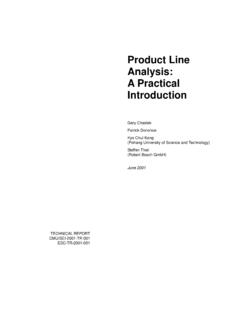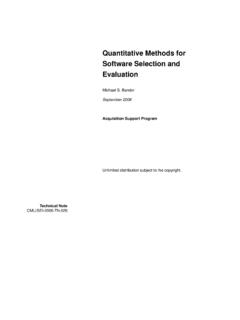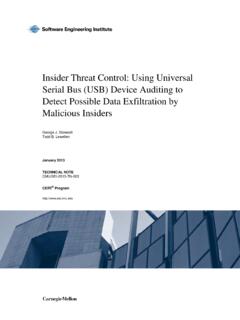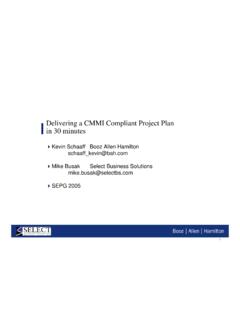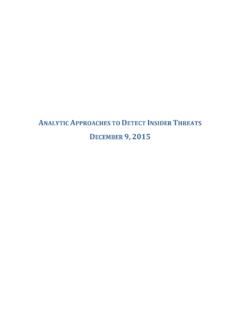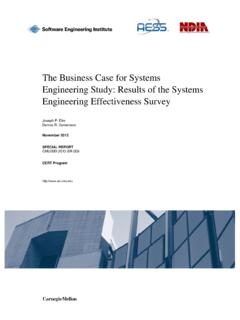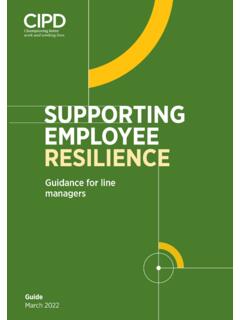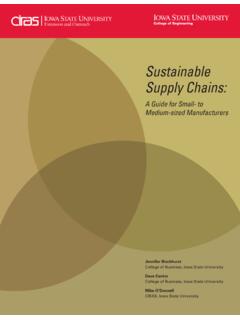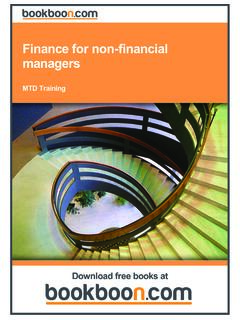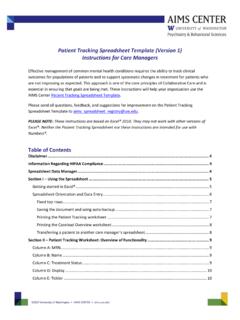Transcription of Guidelines for Developing a Product Line Production Plan
1 Guidelines for Developing a Product line Production Plan Gary Chastek John D. McGregor June 2002 TECHNICAL REPORT CMU/SEI-2002-TR-006 ESC-TR-2002-006 Pittsburgh, PA 15213-3890 Guidelines for Developing a Product line Production Plan CMU/SEI-2002-TR-006 ESC-TR-2002-006 Gary Chastek John D. McGregor June 2002 Product line Practice Initiative Unlimited distribution subject to the copyright. This report was prepared for the SEI Joint Program Office HQ ESC/DIB 5 Eglin Street Hanscom AFB, MA 01731-2116 The ideas and findings in this report should not be construed as an official DoD position. It is published in the interest of scientific and technical information exchange.
2 FOR THE COMMANDER Norton L. Compton, Lt Col, USAF SEI Joint Program Office This work is sponsored by the Department of Defense. The Software Engineering Institute is a federally funded research and development center sponsored by the Department of Defense. Copyright 2002 by Carnegie Mellon University. NO WARRANTY THIS CARNEGIE MELLON UNIVERSITY AND SOFTWARE ENGINEERING INSTITUTE MATERIAL IS FURNISHED ON AN "AS-IS" BASIS. CARNEGIE MELLON UNIVERSITY MAKES NO WARRANTIES OF ANY KIND, EITHER EXPRESSED OR IMPLIED, AS TO ANY MATTER INCLUDING, BUT NOT LIMITED TO, WARRANTY OF FITNESS FOR PURPOSE OR MERCHANTABILITY, EXCLUSIVITY, OR RESULTS OBTAINED FROM USE OF THE MATERIAL. CARNEGIE MELLON UNIVERSITY DOES NOT MAKE ANY WARRANTY OF ANY KIND WITH RESPECT TO FREEDOM FROM PATENT, TRADEMARK, OR COPYRIGHT INFRINGEMENT.
3 Use of any trademarks in this report is not intended in any way to infringe on the rights of the trademark holder. Internal use. Permission to reproduce this document and to prepare derivative works from this document for internal use is granted, provided the copyright and "No Warranty" statements are included with all reproductions and derivative works. External use. Requests for permission to reproduce this document or prepare derivative works of this document for external and commercial use should be addressed to the SEI Licensing Agent. This work was created in the performance of Federal Government Contract Number F19628-00-C-0003 with Carnegie Mel-lon University for the operation of the Software Engineering Institute, a federally funded research and development center.
4 The Government of the United States has a royalty-free government-purpose license to use, duplicate, or disclose the work, in whole or in part and in any manner, and to have or permit others to do so, for government purposes pursuant to the copy-right license under the clause at For information about purchasing paper copies of SEI reports, please visit the publications portion of our Web site ( ). CMU/SEI-2002-TR-006 i Table of Contents 1 Introduction ..1 Production Plan ..2 Creating the Product line Production Using the Production Plan ..6 2 Relevant Characteristics of Product Practice Area Expertise ..7 Market Automated Product Creation ..8 Classification of a Product line .
5 9 3 Issues in Building a Production 11 Production Strategy ..12 Qualities of the Production Strategy ..12 Influences on the Production Interactions Between the Production Strategy and Core Product Developer s Perspective ..15 Building the Production Plan Structure ..16 Core Assets ..17 4 Describing the Product Development Example 1 ..20 Example 2 ..21 Example 3 ..22 5 Specializing the Production Plan for a Specific Product ..23 Selecting and Ordering Process Steps ..23 Developing the Bill of Management Maintaining the Production Plan ..26 ii CMU/SEI-2002-TR-006 6 Using the Production Plan.
6 29 Interactions .. 29 Software Development 29 Product Development 30 Using the Plan Before Product 31 Using the Plan During Product 32 Using the Plan After Product Development .. 33 7 Evaluating the Production Plan ..35 Characteristics of Good 35 Appropriateness for Purpose .. 35 Clarity .. 35 Brevity .. 36 Sufficient Detail .. 36 Internal Modularity .. 36 Internal and External Consistency and Traceability .. 36 37 Evaluation 37 Evaluating the Plan .. 37 8 Future 39 Appendix Practice Areas of the Product Builder Pattern .. 41 49 CMU/SEI-2002-TR-006 iii List of Figures Figure 1: Relationships Between Core-Asset Developers and Product Developers.
7 5 Figure 2: Classification Figure 3: Product line Evolution Along the Classification Figure 4: Production Strategy .. 11 Figure 5: Dynamic Structure of the Product Builder Figure 6: Dynamic Structure of the Product Generation Figure 7: Configurations of Production Figure 8: Integration of the Software and Product Development Processes ..31 Figure 9: The Product Builder Pattern ..41 Figure 10: Use Case iv CMU/SEI-2002-TR-006 CMU/SEI-2002-TR-006 v List of Tables Table 1: Examples.
8 19 Table 2: Rate Table ..26 Table 3: PSP Categories for Size Estimation ..32 Table 4: Phase 1 Requirements Table 5: Phase 2 Architecture Table 6: Phase 3 Architecture Evaluation ..45 Table 7: Phase 4 Component Table 8: Phase 5 Testing ..47 Table 9: Phase 6 Software System Integration ..47 vi CMU/SEI-2002-TR-006 CMU/SEI-2002-TR-006 vii Abstract A Production plan is a description of how core assets are to be used to develop a Product in a Product line .
9 A Product line organization creates such a plan to ensure that the correct core assets are used appropriately to build a specific Product in a specific way. The Production plans and techniques used to create products vary widely from organization to organization and from one Product line to another. Because of this variance, the developers of Production plans need some guidance about the plans form and content. This technical report provides guidance for creating, using, and evaluating a Production plan. In addition, this report presents a classification scheme that describes the characteristics of a Product line organization that influence the form and content of the Production plan.
10 Viii CMU/SEI-2002-TR-006 CMU/SEI-2002-TR-006 1 1 Introduction The purpose of a software Product line organization1 is to create products. Organizations adopt a Product line approach in order to achieve a number of goals [Clements 02a]. These goals include but are not limited to reduced time to market reduced Production costs improved quality A Product line organization seeks to achieve these goals through an architecture-centric prod-uct development approach that achieves strategic reuse of assets.
